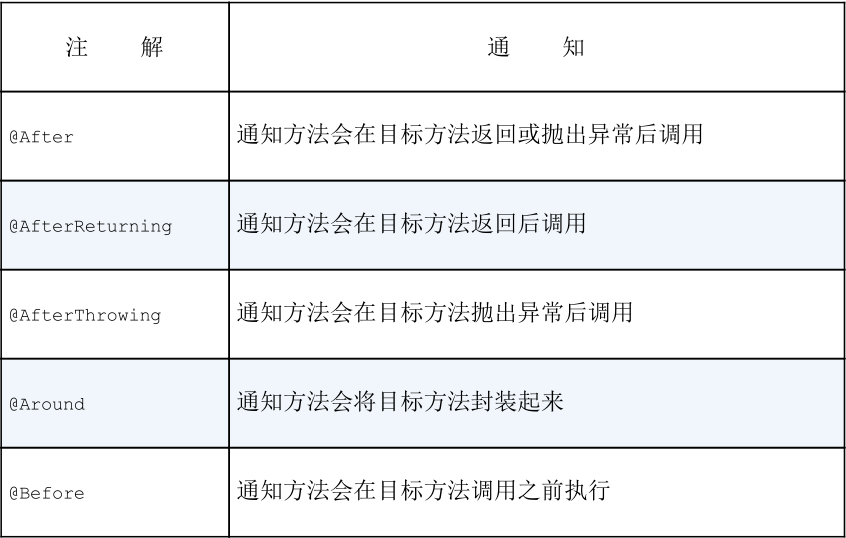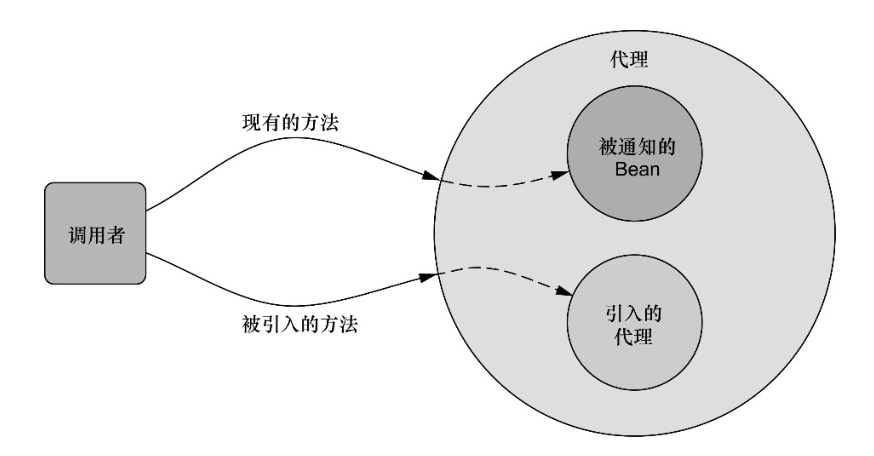Spring使用注解式声明切面与使用
这种在运行时,动态地将代码切入到类的指定方法、指定位置上的编程思想就是面向切面的编程。
AOP是Spring提供的关键特性之一。AOP即面向切面编程,是OOP编程的有效补充。使用AOP技术,可以将一些系统性相关的编程工作,独立提取出来,独立实现,然后通过切面切入进系统。从而避免了在业务逻辑的代码中混入很多的系统相关的逻辑——比如权限管理,事物管理,日志记录等等。这些系统性的编程工作都可以独立编码实现,然后通过AOP技术切入进系统即可。从而达到了 将不同的关注点分离出来的效果。
2 AOP术语
2.1 通知(Advice)
切面必须要完成的工作即称为通知。通知定义了切面是什么以及什么时候实用。
spring切面可以实用的5种类型通知:
- 前置通知(Before):在目标方法被调用之前调用通知功能;
- 后置通知(After):在目标方法完成之后调用通知,此时不会关心方法的输出是什么;
- 返回通知(After-returning):在目标方法成功执行之后调用通知;
- 异常通知(After-throwing):在目标方法抛出异常后调用通知;
- 环绕通知(Around):通知包裹了被通知的方法,在被通知的方法调用之前和调用之后执行自定义的行为。
2.2 连接点(Join point)
我们的应用可能有数以千计的时机应用通知。这些时机被称 为连接点。连接点是在应用执行过程中能够插入切面的一个点。这个点可以是调用方法时、抛出异常时、甚至修改一个字段时。切面代码可以利用这些点插入到应用的正常流程之中,并添加新的行为。
2.3 切点(Poincut)
切点定义了从何处切入。切点的定义会匹配通知所要织入的一个或多个连接点。通常使用明确的类和方法名称,或是利用正则表达式定义所匹配的类和方法名称来指定这些切点。
2.4 切面(Aspect)
切面是通知和切点的结合。通知和切点共同定义了切面的全部内容----它是什么,在何时和何处完成其功能。
2.5 引入(Introduction)
引入允许我们向现有的类添加新方法或属性。
2.6 织入(Weaving)
织入是把切面应用到目标对象并创建新的代理对象的过程。切面在指定的连接点被织入到目标对象中。
- 编译期:切面在目标类编译时被织入。这种方式需要特殊的编译器。AspectJ的织入编译器就是以这种方式织入切面的。
- 类加载期:切面在目标类加载到JVM时被织入。这种方式需要特殊的类加载器(ClassLoader),它可以在目标类被引入应用之前增强该目标类的字节码。AspectJ 5的加载时织入(load-timeweaving,LTW)就支持以这种方式织入切面。
- 运行期:切面在应用运行的某个时刻被织入。一般情况下,在织入切面时,AOP容器会为目标对象动态地创建一个代理对象。Spring AOP就是以这种方式织入切面的。
3 Spring对切面的支持
Spring提供了4种类型的AOP支持:
- 基于代理的经典Spring AOP;
- 纯POJO切面;
- @AspectJ注解驱动的切面;
- 注入式AspectJ切面(适用于Spring各版本)。
前三种都是Spring AOP实现的变体,Spring AOP构建在动态代理基础之上,因此,Spring对AOP的支持局限于方法拦截。
4 认识切点
在Spring AOP中,要使用AspectJ的切点表达式语言来定义切点。
首先定义一个接口来作为切点:
public interface Performance {
void perform();
}
复制代码
假设我们想编写Performance的perform()方法触发的通 知。下面的表达式能够设置当perform()方法执行时触发通知的调用。
execution(* com.wtj.springlearn.aop.Performance.perform(..)) 复制代码
execution()指示器选择Performance的perform()方法。方法表达式以“*”号开始,表明了不关心方法返回值的类型。然后指定了全限定类名和方法名。对于方法参数列表,使用两个点号(..)表明切点要选择任意的perform()方法,无论该方法的入参是什么。
如果我们需要设置切点匹配com.wtj.springlearn.aop包,可以使用within()来限定匹配。
execution(* com.wtj.springlearn.aop.Performance.perform(..)) && within(com.wtj.springlearn.aop.*) 复制代码
表示com.wtj.springlearn.aop包下任意类的方法被调用时。
使用“&&”操作符把execution()和within()指示器连接在一起形成与(and)关系(切点必须匹配所有的指示器)。类似地,我们可以使用“||”操作符来标识或(or)关系,而使用“!”操作符来标识非(not)操作。
因为“&”在XML中有特殊含义,所以在Spring的XML配置里面描述切点时,我们可以使用and来代替“&&”。同样,or和not可以分别用来代替“||”和“!”。
还可以使用bean的ID来标识bean。bean()使用bean ID或bean名称作为参数来限制切点只匹配特定的bean。
execution(* com.wtj.springlearn.aop.Performance.perform(..)) && bean('book')
复制代码
这里表示执行perform方法时通知,但是只限于bean的ID为book。
5 通过注解创建切面
本篇主要介绍注解方式的切面定义方式
通过@Aspect进行标注,表示该Audience不仅是一个POJO还是一个切面。类中的方法表示了切面的具体行为。
Spring提供了五种注解来定义通知时间:

首先创建一个切面:
@Aspect
public class Audience {
//表演前 手机静音
@Before("execution(* com.wtj.springlearn.aop.Performance.perform(..))")
public void silenceCellPhone(){
System.out.println("silence Cell Phone");
}
//表演成功-clap
@AfterReturning("execution(** com.wtj.springlearn.aop.Performance.perform(..))")
public void clap(){
System.out.println("clap clap clap");
}
//表演失败-退款
@AfterThrowing("execution(** com.wtj.springlearn.aop.Performance.perform(..))")
public void refund(){
System.out.println("refund refund refund");
}
}
复制代码
Performance的实现类:
@Component
public class PerformanceImpl implements Performance {
public void perform() {
System.out.println("the perform is good");
}
}
复制代码
最后还需要开启自动代理功能,通过JavaConfig进行配置,使用 @EnableAspectJAutoProxy 标签开启。
@Configuration
@EnableAspectJAutoProxy
@ComponentScan
public class AudienceConfig {
@Bean
public Audience audience(){
return new Audience();
}
}
复制代码
最后通过一个简单的测试用例就可以来验证了。
@RunWith(SpringJUnit4ClassRunner.class)
@ContextConfiguration(classes = AudienceConfig.class)
public class PerformanceTest {
@Autowired
private Performance performance;
@Test
public void perTest(){
performance.perform();
}
}
复制代码
打印结果:
silence Cell Phone the perform is good clap clap clap 复制代码
5.1 @PointCut声明切点
你会发现上面切面的方法中,切点的声明都是一样的,这种情况下可以使用 @Pointcut 注解来定义切点。
@Pointcut("execution(* com.wtj.springlearn.aop.Performance.perform(..))")
public void per(){};
//表演前 手机静音
@Before("per()")
public void silenceCellPhone(){
System.out.println("silence Cell Phone");
}
复制代码
per()方法本身并不重要,该方法只是一个标识,供@PointCut注解依附。
5.2 环绕通知
环绕通知是最为强大的通知类型。它能够让你所编写的逻辑将被通知的目标方法完全包装起来。实际上就像在一个通知方法中同时编写前置通知和后置通知。
重写Audience切面,使用环绕通知替代之前多个不同的前置通知和后置通知。
@Around("per()")
public void watch(ProceedingJoinPoint point) throws Throwable {
try{
System.out.println("silence Cell Phone");
point.proceed();
System.out.println("clap clap clap");
}catch (Exception e){
System.out.println("refund refund refund");
}
}
复制代码
首先注意到的可能是它接受ProceedingJoinPoint作为参数。这个对象是必须要有的,因为你要在通知中通过它来调用被通知的方法。通知方法中可以做任何的事情,当要将控制权交给被通知的方法时,它需要调用ProceedingJoinPoint的proceed()方法。
如果不调proceed()这个方法的话,那么你的通知实际上会阻塞对被通知方法的调用。同样的,你也可以调用多次。
5.3 向通知中传入参数
上面我们创建的切面都很简单,没有任何参数。那么切面能访问和使用传递给被通知方法的参数么?
Performance中新增方法:
void perform(String name); 复制代码
实现类:
public void perform(String name) {
System.out.println("下面请 "+name+" 开始他的表演");
}
复制代码
修改Audience中的切点和切面
@Pointcut("execution(* com.wtj.springlearn.aop.Performance.perform(String)) && args(name)")
public void per(String name){};
@Around("per(name)")
public void toWatch(ProceedingJoinPoint point,String name) throws Throwable {
try{
point.proceed();
System.out.println(name +" 上场啦");
System.out.println(name +" 演出结束");
}catch (Exception e){
System.out.println("refund refund refund");
}
}
复制代码
表达式 args(name) 限定符,它表示传递给perform(String name)方法的String类型参数也会传到通知中去,参数名与切点中的参数名相同。 perform(String) 指明了传入参数的类型。
然后在 @Around 注解中指明切点与参数名,这样就完成了参数转移。
最后修改一下测试用例就完成了
@Test
public void perTest(){
performance.perform("渣渣辉");
}
复制代码
打印输出:
下面请 渣渣辉 开始他的表演 渣渣辉 上场啦 渣渣辉 演出结束 复制代码
5.4 通过注解@DeclareParents引入新方法
如果我们想在一个类上新增方法,通常情况下我们会怎么做呢?最简单的办法就是在此目标类上增加此方法,但是如果原目标类非常复杂,动一发而牵全身。并且有些时候我们是没有目标类的源码的,哪这个时候怎么办呢?
我们可以为需要添加的方法建立一个类,然后建一个代理类,同时代理该类和目标类。用一个图来表示

当引入接口的方法被调用时,代理会把此调用委托给实现了新接口的某个其他对象。
还是上面的例子,假设我们需要让表演者跳起来。
新建Jump接口以及实现类:
public interface Jump {
void duJump();
}
复制代码
public class JumpImpl implements Jump {
public void duJump() {
System.out.println("do Jump");
}
}
复制代码
然后我们代理两个类:
@Aspect
public class JumpIntroducer {
@DeclareParents(value = "com.wtj.springlearn.aop.Performance+",defaultImpl = JumpImpl.class)
public static Jump jump;
}
复制代码
@DeclareParents注解由三部分组成:
- value属性指定了哪种类型的bean要引入该接口。在本例中,也就是所有实现Performance的类型。(标记符后面的加号表示是Performance的所有子类型,而不是Performance本 身。)
- defaultImpl属性指定了为引入功能提供实现的类。
- @DeclareParents注解所标注的静态属性指明了要引入了接 口。
通过配置将JumpIntroducer声明
@ComponentScan
@Configuration
@EnableAspectJAutoProxy
public class JumpConfig {
@Bean
public JumpIntroducer jumpIntroducer(){
return new JumpIntroducer();
}
}
复制代码
或者你也可以在JumpIntroducer类上加入 @Component 注解,就可以不用声明bean了。
最后通过测试用例进行测试:
@RunWith(SpringJUnit4ClassRunner.class)
@ContextConfiguration(classes = JumpConfig.class)
public class PerformanceTest {
@Autowired
private Performance performance;
@Test
public void perTest(){
//类型转换
Jump jump = (Jump) performance;
jump.duJump();
}
}
复制代码
打印结果:
do Jump 复制代码











![[HBLOG]公众号](https://www.liuhaihua.cn/img/qrcode_gzh.jpg)

